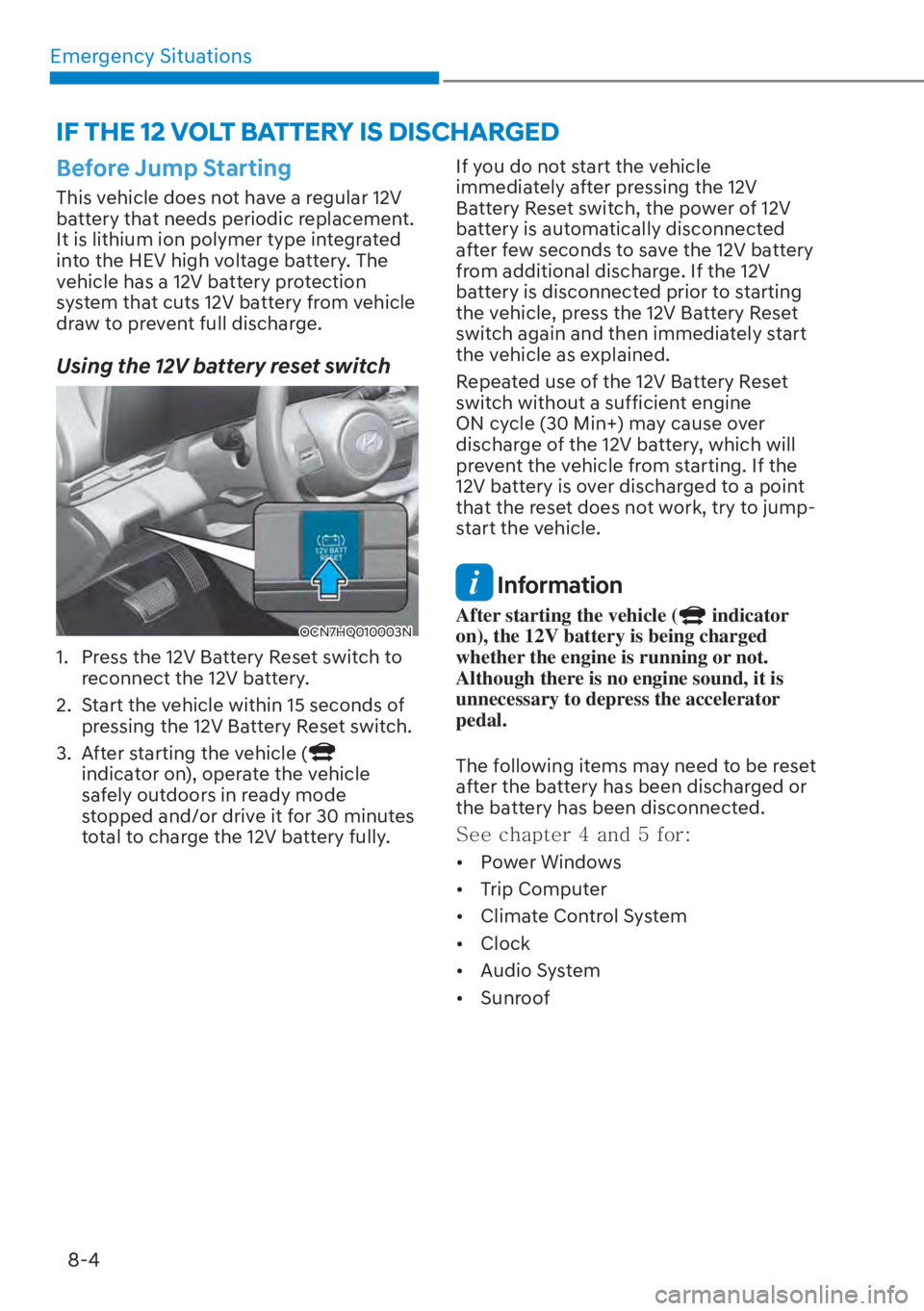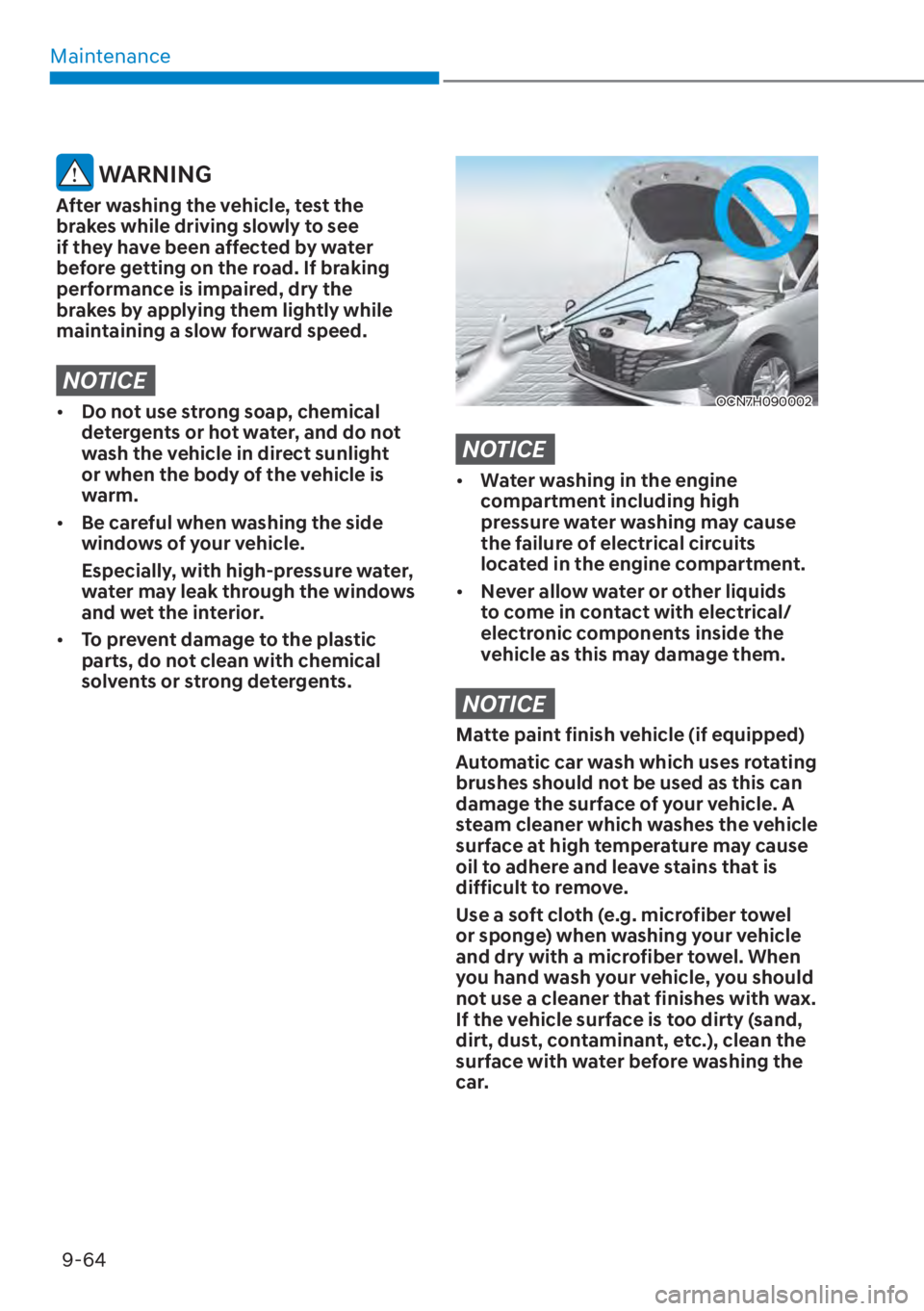Page 448 of 543

Emergency Situations8-4
Before Jump Starting
This vehicle does not have a regular 12V
battery that needs periodic replacement.
It is lithium ion polymer type integrated
into the HEV high voltage battery. The
vehicle has a 12V battery protection
system that cuts 12V battery from vehicle
draw to prevent full discharge.
Using the 12V battery reset switch
OCN7HQ010003N
1. Press the 12V Battery Reset switch to reconnect the 12V battery.
2. Start the vehicle within 15 seconds of pressing the 12V Battery Reset switch.
3. After starting the vehicle (
indicator on), operate the vehicle
safely outdoors in ready mode
stopped and/or drive it for 30 minutes
total to charge the 12V battery fully. If you do not start the vehicle
immediately after pressing the 12V
Battery Reset switch, the power of 12V
battery is automatically disconnected
after few seconds to save the 12V battery
from additional discharge. If the 12V
battery is disconnected prior to starting
the vehicle, press the 12V Battery Reset
switch again and then immediately start
the vehicle as explained.
Repeated use of the 12V Battery Reset
switch without a sufficient engine
ON cycle (30 Min+) may cause over
discharge of the 12V battery, which will
prevent the vehicle from starting. If the
12V battery is over discharged to a point
that the reset does not work, try to jump-
start the vehicle.
Information
After starting the vehicle ( indicator
on), the 12V battery is being charged
whether the engine is running or not.
Although there is no engine sound, it is
unnecessary to depress the accelerator
pedal.
The following items may need to be reset
after the battery has been discharged or
the battery has been disconnected.
�4�F�F���D�I�B�Q�U�F�S�������B�O�E�������G�P�S��
�[�� Power Windows
�[�� Trip Computer
�[�� Climate Control System
�[�� Clock
�[�� Audio System
�[�� Sunroof
IF THE 12 VOLT BATTERY IS DISCHARGED
Page 496 of 543

Maintenance9-28
Blade Inspection
Contamination of either the windshield
or the wiper blades with foreign matter
can reduce the effectiveness of the
windshield wiper functionality. Common
sources of contamination are insects,
tree sap, and hot wax treatments used
by some commercial car washes. If the
blades are not wiping properly, clean
both the window and the blades with a
clean cloth dampened with washer fluid.
NOTICE
To prevent damage to the wiper blades,
arms or other components, do not:
�[�� Use gasoline, kerosene, paint
thinner, or other solvents on or near
them.
�[�� Attempt to move the wipers
manually.
�[�� Use non-specified wiper blades.
Information
Commercial hot waxes applied by
automatic car washes have been known to
make the windshield difficult to clean.
Blade Replacement
When the wipers no longer clean
adequately, the blades may be worn or
cracked, and require replacement.
NOTICE
�[��In order to prevent damage to the
hood and the wiper arms, the wiper
arms should only be lifted when in
the top wiping position.
�[�� Always return the wiper arms to the
windshield before driving.
NOTICE
The use of a non-specified wiper blade
could result in wiper malfunction and
failure.
WIPER BLADES
Page 516 of 543

Maintenance9-48
Driver’s side fuse panel
Fuse Name Fuse Rating Circuit Protected
MEMORY1 10
AA/C Controller, Instrument Cluster,
A/C Control Module, Driver IMS Control Module
AIR BAG2 10A SRS Control Module
MODULE4 10AIBU, ATM Shift Lever Indicator, Front Console Switch,
ADAS Unit, Crash Pad Switch, LKA Unit, VESS Unit
MODULE7 7.5AIAU, ADAS Unit, Rear Seat Wamer Control Module,
Cooling Fan Motor
START 7.5ABurglar Alarm Relay, Transaxle Range Switch, IBU,
Ignition Switch
BATTERY
MANAGEMENT 10A BMS Control Module
CLUSTER 7.5A Instrument Cluster (IG1)
IBU2 7.5A IBU
A/C1 7.5AA/C Controller, A/C Control Module, PM Sensor,
E/R Junction Block (Blower Relay, PTC Heater1/2 Relay),
Electronic A/C Compressor
TRUNK 10A Trunk Relay
S/HEATER FRT 20AFront Ventilation Seat Control Module,
Front Seat Warmer Control Module
P/WINDOW LH 25A Power Window Main Switch
MULTIMEDIA 15A Audio, A/V & Navigation Head Unit
SPARE 1 (B+) 10A Not Used (Black Box)
FCA 10A Front Radar
MDPS 7.5A MDPS Unit
MODULE6 7.5A IBU
S/HEATER RR 20A Rear Seat Warmer Control Module
SAFETY P/
WINDOW DRV 25A Driver Safety Power Window Module
P/WINDOW RH 25APassenger Power Window Switch,
Power Window Main Switch
BRAKE SWITCH 10A IBU, Stop Lamp Switch
IBU1 15A IBU
Page 519 of 543
09
9-51
Engine compartment fuse panel
Type Fuse NameFuse Rating Circuit Protected
MULTI
FUSE
-3 MDPS
80A MDPS Unit
MULTI
FUSE-2 COOLING FAN
60A Cooling Fan Motor
IEB 3 60A IDB Unit
PTC HEATER 2 50A PTC Heater 2 Relay
MULTI
FUSE-1 B+5
60APCB Block (Engine Control Relay, Fuse -
ECU 2/HORN/WIPER)
B+1 60AICU Junction Block (IPS2/IPS5/IPS6/IPS7/
IPS14)
B+2 60AICU Junction Block (IPS1/IPS4/IPS8/IPS9/
IPS10)
B+3 50AFuse - EWP 2, ICU Junction Block (Fuse -
SAFETY P/WINDOW DRV, TRUNK, AMP, P/
SEAT DRV, P/SEAT PASS, S/HEATER FRT, S/
HEATER RR, Long Term Load Latch Relay
(Fuse - MEMORY 1/MULTIMEDIA))
IEB 2 60A IDB Unit
PTC HEATER 1 50A PTC Heater 1 Relay
BLOWER 40ABlower Relay, Multipurpose Check
Connector
IG1 40A Ignition Switch, PDM (IG1/ACC) Relay
IG2 40A Ignition Switch, PDM (IG2) Relay
Page 520 of 543
Maintenance9-52
Engine compartment fuse panel
Type Fuse Name Fuse Rating Circuit Protected
FUSE B
ATTERY C/
FAN 1 15A Battery C/Fan Relay
IEB1 40A IDB Unit, Multipurpose Check Connector
CLUTCH
ACTUATOR 30A Clutch Actuator
POWER
OUTLET 1 40A Power Outlet Relay
EWP 2 10A Auxiliary Electric Water Pump
EWP 1 10A Electric Water Pump
POWER
OUTLET 2 20A Front Power Outlet
DCT 1 40A TCM
DCT 2 40A TCM
REAR
HEATED 40A Rear Heated Relay
B+4 40AICU Junction Block (Power Window Relay,
Fuse - AIR BAG 2, IBU 1, BRAKE SWITCH,
DOOR LOCK, MODULE 1, SUNROOF, IAU,
BMS)
HEV ECU 1 10A HPCU
IG3 20A IG3 Relay
TCU 1 10A TCM
FUEL PUMP 20A Fuel Pump Relay
HEV ECU 2 10A HPCU, BMS Control Module
Sub Block FUSE BATTERY C/
FAN 2 10A Battery C/Fan Relay
Page 532 of 543

Maintenance9-64
WARNING
After washing the vehicle, test the
brakes while driving slowly to see
if they have been affected by water
before getting on the road. If braking
performance is impaired, dry the
brakes by applying them lightly while
maintaining a slow forward speed.
NOTICE
�[�� Do not use strong soap, chemical
detergents or hot water, and do not
wash the vehicle in direct sunlight
or when the body of the vehicle is
warm.
�[�� Be careful when washing the side
windows of your vehicle.
Especially, with high-pressure water,
water may leak through the windows
and wet the interior.
�[�� To prevent damage to the plastic
parts, do not clean with chemical
solvents or strong detergents.OCN7H090002
NOTICE
�[��Water washing in the engine
compartment including high
pressure water washing may cause
the failure of electrical circuits
located in the engine compartment.
�[�� Never allow water or other liquids
to come in contact with electrical/
electronic components inside the
vehicle as this may damage them.
NOTICE
Matte paint finish vehicle (if equipped)
Automatic car wash which uses rotating
brushes should not be used as this can
damage the surface of your vehicle. A
steam cleaner which washes the vehicle
surface at high temperature may cause
oil to adhere and leave stains that is
difficult to remove.
Use a soft cloth (e.g. microfiber towel
or sponge) when washing your vehicle
and dry with a microfiber towel. When
you hand wash your vehicle, you should
not use a cleaner that finishes with wax.
If the vehicle surface is too dirty (sand,
dirt, dust, contaminant, etc.), clean the
surface with water before washing the
car.
Page 539 of 543
09
9-71
Cleaning the seat belt webbing
Clean the belt webbing with any
mild soap solution recommended for
cleaning upholstery or carpet. Follow
the instructions provided with the soap.
Do not bleach or re-dye the webbing
because this may weaken the seat belt.
Cleaning the interior window glass
If the interior glass surfaces of the
vehicle become hazy (that is, covered
with an oily, greasy or waxy film), they
should be cleaned with glass cleaner.
Follow the directions on the glass cleaner
container.
NOTICE
Do not scrape or scratch the inside of
the rear window. This may result in
damage to the rear window defroster
grid.
Page 541 of 543

09
9-73
3. Exhaust Emission Control System
The Exhaust Emission Control System is
a highly effective system which controls
exhaust emissions while maintaining
good vehicle performance.
When the engine starts or fails to start,
excessive attempts to restart the engine
may cause damage to the emission
system.
Engine exhaust (carbon monoxide)
precautions
�[�� Carbon monoxide can be present
with other exhaust fumes. If you smell
exhaust fumes of any kind in your
vehicle, drive with all the windows
fully open. Have your vehicle checked
and repaired immediately.
WARNING
Engine exhaust gases contain carbon
monoxide (CO). Though colorless and
odorless, it is dangerous and could be
lethal if inhaled. Follow the instructions
on this page to avoid CO poisoning.
WARNING
CALIFORNIA PROPOSITION 65
WARNING
Engine exhaust and a wide variety of
automobile components and parts,
including components found in the
interior furnishings in a vehicle, contain
or emit chemicals known to the State
of California to cause cancer and
birth defects and reproductive harm.
In addition, certain fluids contained
in vehicles and certain products of
component wear contain or emit
chemicals known to the State of
California to cause cancer and birth
defects or other reproductive harm. �[��
Do not operate the engine in confined
or closed areas (such as garages) any
more than what is necessary to move
the vehicle in or out of the area.
�[�� When the vehicle is stopped in an
open area for more than a short time
with the engine running, adjust the
ventilation system (as needed) to draw
outside air into the vehicle.
�[�� Never sit in a parked or stopped
vehicle for any extended time with the
engine running.
�[�� When the engine stalls or fails to
start, excessive attempts to restart
the engine may cause damage to the
emission control system.